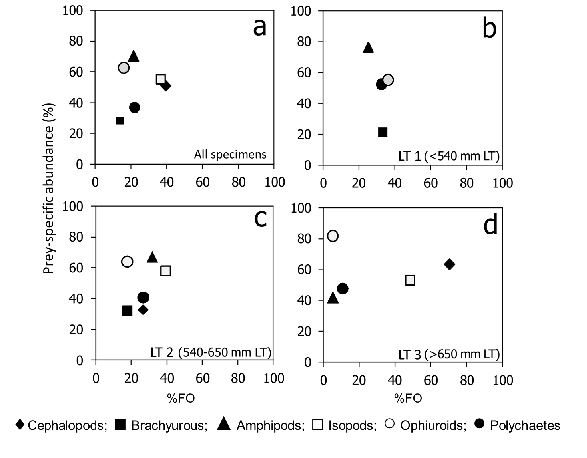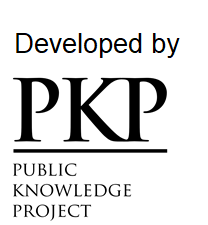Trophic ecology of hairy conger eel Bassanago albescens in the Southwest Atlantic and its implications for the ecosystem-based fishery management
DOI:
https://doi.org/10.47193/mafis.3422021010605Keywords:
Anguilliformes, ecosystem-based fishery management, feeding habits, ontogenetic changesAbstract
This study aimed to determine the diet composition and feeding strategies of the hairy conger eel Bassanago albescens in the Southwest Atlantic (35° S-45° S), from stomach contents analysis of 222 specimens. The diet consisted mainly of cephalopods, followed by isopods, amphipods, ophiuroids, brachyurous and polychaetes. Results showed significant differences in the composition of the diet between sexes, regions and size classes that were reflected in the changes in the foraging strategy. The consumption of squid Illex argentinus progressively increased with a growing predator size, where the largest individuals showed specialization in the consumption of this particular prey. We propose these dietary changes would be related to morphological limitations and abilities associated with the body size of B. albescens, with larger individuals having access to larger prey. Our results help to understand the biology of a species that has a sympatric distribution with two key species in the Argentine fisheries: hake Merluccius hubbsi and I. argentinus, with evidence of a strong trophic interaction between them. This new information on the resources involved would allow an optimization of the fisheries management under an ecosystem-based criterion.
Downloads
Metrics
References
Amundsen PA, Gabler H, Staldvik F. 1996. A new approach to graphical analysis of feeding strategy from stomach contents data modification of the Costello (1990) method. J Fish Biol. 48: 607-614.
Amundsen PA, Sánchez-Hernández J. 2019. Feeding studies take guts - critical review and recommendations of methods for stomach contents analysis in fish. J Fish Biol. 95: 1364-1373.
Anderson ME. 2005. Food habits of some deep-sea fish off South Africa’s west coast. 2. Eels and spiny eels. Afr J Mar Sci. 27: 557-566.
Anderson MJ. 2001. Permutation test for univariate o multivariate analysis of variance and regression. Can J Fish Aquat Sci. 58: 629-639.
Arkhipkin AI, Laptikhovsky VV, Barton AJ. 2015. Biology and fishery of common hake (Merluccius hubbsi) and southern hake (Merluccius australis) around the Falkland/Malvinas Islands on the Patagonian shelf of the Southwest Atlantic Ocean. In: Arancibia H, editor. Hakes, biology and exploitation. Oxford: Wiley. p. 154-184.
Bastida R, Torti M. 1973. Los isópodos Serolidae en la Argentina. Clave para su reconocimiento. Physis A. 32 (84): 19-46.
Belleggia M, Figueroa DE, Irusta G, Bremec C. 2014. Spatio-temporal and ontogenetic changes in the diet of the Argentine hake Merluccius hubbsi. J Mar Biol Assoc UK. 94: 1701-1710.
Blasina GE, Izzo L, Figueroa D. 2018. Sexual dimorphism and length-weight relationship of the hairy conger eel Bassanago albescens (Anguilliformes: Congridae). J Ichthyol. 58 (3): 396-400.
Boschi E, Fischbach C, Iorio M. 1992. Catálogo ilustrado de los crustáceos estomatópodos y decápodos marinos de Argentina. Frente Marít. 10: 7-94.
Branch TA, Watson R, Fulton EA, Jennings S, McGilliard RC, Pablico GT, Ricard D, Tracey SR. 2010. The trophic fingerprint of marine fisheries. Nature. 468: 431-435.
Bremec C, Marecos A, Schejter L, Lasta M. 2003. Guía técnica para la identificación de invertebrados epibentónicos asociados a los bancos de vieira patagónica (Zygochlamys patagonica) en el Mar Argentino. Mar del Plata: Instituto Nacional de Investigación y Desarrollo Pesquero (INIDEP). 28 p.
Brose U, Archambault P, Barnes AD, Bersier LF, Boy T, Canning-Clode J, Conti E, Dias M, Digel C, Dissanayake A, et al. 2019. Predator traits determine food-web architecture across ecosystems. Nat Ecol Evol. 3: 919-927.
Brown SC, Bizzarro JJ, Cailliet GM, Ebert DA. 2012. Breaking with tradition: redefining measures for diet description with a case study of the Aleutian skate Bathyraja aleutica (Gilbert 1896). Environ Biol Fish. 95 (1): 3-20.
Buratti C, Díaz de Astarloa JM, Falabella V, Hüne M, Irigoyen A, Landaeta M, Linardich C, Riestra C, Vieira J, Campagna C. 2020. Informe del Taller Regional de Evaluación del Estado de Conservación de Especies para el Mar Patagónico según criterios de la Lista Roja de UICN: Peces óseos. Foro para la Conservación del Mar Patagónico y áreas de influencia. 117 p.
Cortés E. 1999. Standardized diet compositions and trophic levels of sharks. ICES J Mar Sci. 56 (5): 707-717.
Craing CM, Halpern BS, Beck MW, Kappel CV. 2009. Understanding and managing human threats to the coastal marine environment. Ann NY Acad Sci. 1162 (1): 39-62.
Ebert DA, Bizzarro JJ. 2007. Standardized diet compositions and trophic levels of skates (Chondrichthyes: Rajiformes: Rajoidei). Environ Biol Fishes. 80: 115-131.
[FAO] Food and Agriculture Organization of the United Nation. 2018. The state of world fisheries and aquaculture. Rome: FAO. 227 p.
Ferry L, Cailliet G. 1996. Sample size and data analysis: are we characterizing and comparing diet properly? In: Mac Kinlay D, Shearer K, editors. Feeding ecology and nutrition in fish. San Francisco: American Fisheries Society. p. 71-80.
Figueroa D. 1992. Distribución geográfica y estadísticas pesqueras de los congrios Conger orbignyanus y Pseudoxenomystax albescens. Frente Marít. 11 (A): 33-36.
Figueroa D. 1999. Estudio sobre la anatomía y algunos aspectos de la biología de los congrios que habitan el Mar Argentino y adyacencias [PhD thesis]. Mar del Plata: Facultad de Ciencias Exactas y Naturales, Universidad Nacional de Mar del Plata. 108 p.
Figueroa DE, Ehrlich M. 2006. Systematics and distribution of leptocephali in the western south Atlantic. Bull Mar Sci. 78 (2): 227-242.
Floeter J, Temming A. 2003. Explaining diet composition of North Sea cod (Gadus morhua): prey size preference vs. prey availability. Can J Fish Aquat Sci. 60: 140-150.
Froese R. 2006. Cube law, condition factor and weight-length relationships: history, meta-analysis and recommendations. J Appl Ichthyol. 22: 241-253.
García M, Jaureguizar A, Protogino L. 2010. Fish community ecology from Río de la Plata to shelf slope. Lat Am J Aquat Res. 38 (1): 81-94.
Griffiths D. 1980. Foraging costs and relative prey size. Am Nat. 116: 743-752.
Griffiths D. 2020. Foraging habitat determines predator-prey size relationships in marine fishes. J Fish Biol. 97 (4): 964-973.
Haimovici M, Brunetti NE, Rodhouse PG, Csirke J, Leta RH. 1998. Illex argentinus. In: Rodhouse PG, Dawe EG, Dor RKO, editors. Squid recruitment dynamics. The genus Illex as a model, the commercial Illex species and influence on variability. FAO Fish Tech Pap. 376. p. 27-58
Hayden B, Palomares MLD, Smith BE, Poelen JH. 2019. Biological and environmental drivers of trophic ecology in marine fishes- a global perspective. Nat Sci Rep. 9: 11415.
Hill S, Hinke J, Bertrand S, Fritz L, Furness R, Ianelli J, Murphy M, Oliveros-Ramos R, Pichegru L, Sharp R, Stillman R, Wright P, Ratcliffe N. 2020. Reference points for predators will progress ecosystem-based management of fisheries. Fish Fish. 21 (2): 368-378.
Hooper D, Chapin F, Ewel J, Hector A, Inchausti P, Lavorel S, Lawton J, Lodge D, Loreau M, Naeem S, et al. 2005. Effects of biodiversity on ecosystem functioning: a consensus of current knowledge. Ecol Monogr. 75 (1): 3-35.
Irusta C, Macchi G, Louge E, Rodrigues K, D’Atri L, Villarino M, Santos B, Simonazzi M. 2016. Biology and fishery of the Argentine hake (Merluccius hubbsi). Rev Invest Desarr Pesq. 28: 9-36.
Killen S, Brown J, Gamperl A. 2007. The effect of prey density on foraging mode selection in juvenile lumpfish: balancing food intake with the metabolic cost of foraging. J Anim Ecol. 76: 814-825.
Lercari D, Vögler R, Velasco G. 2014. Trophic models in the Southwestern Atlantic Ocean: evaluating. Fish Cent Res Rep. 22 (3): 75 p.
Livingston R. 2003. Trophic organization in coastal systems. Tallahassee: CRC. Florida University. 388 p.
Macchi G, Leonarduzzi E, Diaz M, Renzi M, Rodrigues K. 2013. Maternal effects on fecundity and egg quality of the Patagonian stock of Argentine hake (Merluccius hubbsi). Fish Bull. 111 (4): 325-336.
Macchi G, Martos P, Reta R, Dato C. 2010. Offshore spawning of the Argentine hake (Merluccius hubbsi) Patagonian stock. Pan Am J Aquat Sci. 5: 22-35.
Meyer M, Smale M. 1991. Predation patterns of demersal teleosts from the Cape south and west coasts of South Africa. 2. Benthic and epibenthic predators. S Afr J Mar Sci. 11: 409-442.
Mihalitsis M, Bellwood D. 2017. A morphological and functional basis for maximum prey size in piscivorous fishes. PLoS ONE: e0184679.
[MAGyP] Ministerio de Agricultura, Ganadería y Pesca. 2019. [accessed 2021 February]. https://www.magyp.gob.ar/.
Pikitch E, Santora C, Babcock E, Bakun A, Bonfil R, Conover D, Dayton P, Doukakis P, Fluharty D, Heneman B, Houde E. 2004. Ecosystem-based fishery management. Science. 305 (5682): 346-347.
R Core Team. 2019. R: a language and environment for statistical computing. R Foundation for Statistical Computing. [accessed 2020 December]. http://www.r-project.org/index.html.
Ré ME. 2007. Cefalópodos. Illex argentinus. In: Boltovskoy D, editor. Atlas de sensibilidad ambiental de la costa y el Mar Argentino. Ciudad Autónoma de Buenos Aires: Secretaría de Ambiente y Desarrollo Sustentable. 5 p.
Renzi M, Castrucci R. 1998. Análisis cuali-cuantitativo de la fauna acompañante en la pesquería de merluza (Merluccius hubbsi) al norte de 41° S. Inf Téc Int DNI-INIDEP. 24/1998. 20 p.
Reyes P. 2007. Peces abisales de la ‘Triple Unión’, lugar de contacto de las placas Antártica, Sudamericana y de Nazca (archipiélago patagónico noroccidental). Rev Biol Mar Oceanogr. 42 (1): 37-47.
San Martín M, Braccini L, Chiaramonte G, Pérez J. 2007. Temporal and sexual effects in the feeding ecology of the marbled sand skate Psammobatis bergi Marini, 1932. Mar Biol. 151: 505-513.
Stephens D, Brown J, Ydenberg R. 2007. Foraging. Behavior and ecology. Chicago: The University of Chicago Press. 608 p.
Stuart-Smith R, Bates A, Lefcheck J, Duffy J, Baker S, Thomson R, Stuart-Smith J, Hill N, Kininmonth S, Airoldi L, et al. 2013. Integrating abundance and functional traits reveals new global hotspots of fish diversity. Nature. 501: 539-542.
Zar JH. 1999. Biostatistical Analysis, 4th ed. New York: Prentice Hall. 663 p.
Zuur A, Ieno E, Smith G. 2007. Analysing ecological data. New York: Springer. 672 p.

Published
How to Cite
Issue
Section
License
Copyright (c) 2021 Gabriela Blasina, Luciano Izzo, Agustín De Wysiecki, Daniel Figueroa

This work is licensed under a Creative Commons Attribution-NonCommercial-ShareAlike 4.0 International License.
Authors of articles published in Marine and Fishery Sciences retain copyright on their articles, except for any third-party images and other materials added by Marine and Fishery Sciences, which are subject to copyright of their respective owners. Authors are therefore free to disseminate and re-publish their articles, subject to any requirements of third-party copyright owners and subject to the original publication being fully cited. Visitors may also download and forward articles subject to the citation requirements. The ability to copy, download, forward or otherwise distribute any materials is always subject to any copyright notices displayed. Copyright notices must be displayed prominently and may not be obliterated, deleted or hidden, totally or partially.
This journal offers authors an Open Access policy. Users are allowed to read, download, copy, distribute, print, search, or link to the full texts of the articles, or use them for any other legal purpose within the Creative Commons 4.0 license (BY-NC-SA), without asking prior permission from the publisher or the author. This is in accordance with the BOAI definition of Open Access.




























